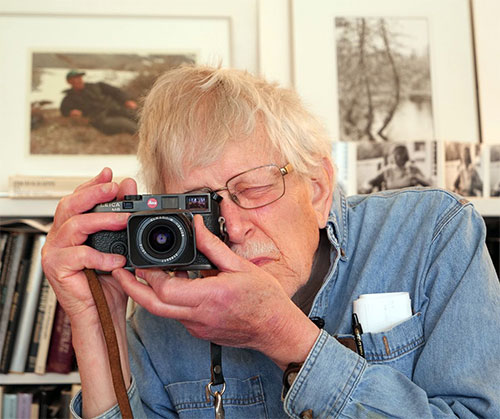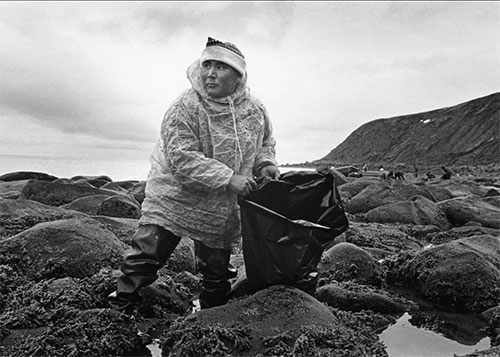Barker is pictured here in April at his home in Fairbanks. |
A panel of Alaska artists and art experts helps the Foundation select a Distinguished Artist from a slate of nominees.
“His photographs are visual vignettes, capturing intimate moments that we normally never get to share. But whether he takes us to a seal hunt on the Bering Sea or a research trip to Antarctica, he finds beauty and reveals something universal in us all,” said Diane Kaplan, Rasmuson Foundation president and CEO.
The late Yup’ik educator Mary Ciuniq Pete once commented: “In his work, he has captured Yup’iks unabashedly being Yup’iks.” Reflecting on his photographs of Yup’ik subsistence, Barker says “I realize that I have responded most to … moments when the people I visited and traveled with were most at peace with themselves and with each other, when they were most thoughtful, intelligent and vital.”
Barker grew up in Pullman, Washington, studied photography at the Art Center School of Design in Los Angeles, then returned to work as a research photographer at Washington State University. Outside of his day job he chose to photograph people.
In 1965, WSU gave him an unexpected opportunity to grab camera and film, fly to Selma, Alabama, and join the civil rights march to Montgomery. Barker’s photographs offer a rare window into that historic moment.
Jesse Paul of Kipnuk is wearing a seal gut parka as he collects herring roe on seaweed on nearby Nelson Island in 1981. |
At San Francisco State College, he studied anthropology, learning about participant-observation and how culture underpins life. In this period, he undertook his first major ethnographic project, focused on a family of 11 living on welfare.
Barker came to Alaska for the first time in the winter of 1970, visiting his brother in Bethel. Three years later he returned to do a photography project for the Yukon-Kuskokwim Health Corp., and there he stayed, intensely interested and deeply involved in community life. Barker’s extensive portfolio from Southwest Alaska forms the heart of his body of work. Rarely without a camera, he photographed almost everything he participated in, from steam bathing to Russian Orthodox Slaviq, from salmon processing to public meetings. Prints emerged from his home darkroom to create a visual story in books, homes, museums, galleries, public service flyers and state buildings.
In 1987, after 14 years in Bethel, Barker, his wife, Robin, and their young son moved to the Interior. There, he became an integral part of the Fairbanks arts community, teaching photography at the University of Alaska Fairbanks.
|
His photographs of Yup’ik dance made over three decades provided the imagery for the award-winning “Yupiit Yuraryarait/Yup’ik Ways of Dancing” with text by Ann Fienup-Riordan and Theresa Arevgaq John. Another book, “Always Getting Ready/Upterllainarluta,” written with Robin, made it into the hands of President Clinton, a gift from the Alaska Federation of Natives. Twice, the National Science Foundation accepted Barker into its Antarctic Artists and Writers Program, and those photographs have long been exhibited at McMurdo Station. The early Selma photographs landed in the Rosa Parks Museum and the Steven Kasher Gallery in New York City.
Along the way, he has been honored with the Alaska Governor’s Award in the Humanities and Lifetime Achievement awards from the Cama-i Festival and the Alaska Press Club.
The recognition is part of the Foundation’s Individual Artist Awards. The remaining 2022 awards — 25 Project Awards and 10 Fellowships — will be announced in the fall.
Edited By: Mary Kauffman, SitNews
Source of News:
Rasmuson Foundation
rasmuson.org
Representations of fact and opinions in comments posted are solely those of the individual posters and do not represent the opinions of Sitnews.
Send a letter to the editor@sitnews.us
SitNews ©2022
Stories In The News
Ketchikan, Alaska
Articles & photographs that appear in SitNews are considered protected by copyright and may not be reprinted without written permission from and payment of any required fees to the proper freelance writers and subscription services.
E-mail your news & photos to editor@sitnews.us
Photographers choosing to submit photographs for publication to SitNews are in doing so granting their permission for publication and for archiving. SitNews does not sell photographs. All requests for purchasing a photograph will be emailed to the photographer.


